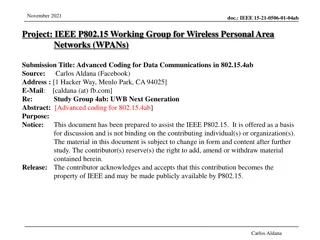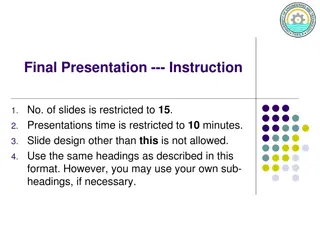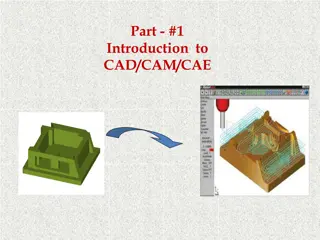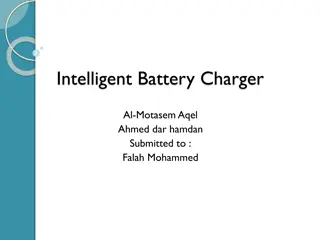AEV Presentation: Final Design and Coding Process Overview
An overview of the AEV presentation featuring Sean Finnessy, Di Wu, and Dalton Rowell, showcasing the final design, coding process, energy analysis, and conclusions. The final design named "Slave" includes an L-shaped arm, strategically placed battery and Arduino, and reversed propellers for enhanced efficiency. The advantages and disadvantages of the design are discussed, highlighting its aesthetics and center of gravity but also noting its heaviness and non-aerodynamic body. The Arduino coding details are presented, focusing on distance measurement and motor speed selection. Implementation included trials to refine the performance, and the final code overview emphasizes speed consistency and energy efficiency.
Download Presentation

Please find below an Image/Link to download the presentation.
The content on the website is provided AS IS for your information and personal use only. It may not be sold, licensed, or shared on other websites without obtaining consent from the author. Download presentation by click this link. If you encounter any issues during the download, it is possible that the publisher has removed the file from their server.
E N D
Presentation Transcript
AEV Presentation Sean Finnessy, Di Wu, Dalton Rowell
Overview Final Design Coding Process Energy Analysis Final test Conclusion
Final Design Chosen Front and back of the final AEV design. Named Slave .9 . L-Shaped arm. Battery located on upper backside. Arduino located lower frontside. EP-3030 Propellers are reversed for increased efficiency.
Advantages and Disadvantages of this design Advantages o Aesthetically pleasing (quite different from other AEV designs.) o Center of gravity is almost perfect (body does not swing at all when moving). o Reversed propellers allow for great efficiency when pushing caboose. (Pusher configuration is more energy efficient). Disadvantages Very heavy design Non-aerodynamic body Would have been more aerodynamic, however we never received the 3D printed shell.
Arduino Coding Process Plan: 1) Distance measured. Marks calculated. Used goToRelativePosition(); function. This function makes a command go until it reaches the amount of marks entered. 1) Referred to EP-3030 wind tunnel efficiency data to find the best motor speed to use for efficiency concern. 30% motor speed was used throughout the run. 2) To completely stop the AEV, 30% was used for 1.5 seconds to stop the AEV completely. Any less and it would drift. Any more and it would travel backwards.
Implementation 1. Trials were performed and errors were resolved during the performance test to find the perfect amount of marks needed (AEV drifted a bit which made it difficult to find perfect amount). 2. Multiple tests ran to get the code down perfectly (trial and error).
Final Code overview Constant 30% speed used throughout code. Except when accelerating, set to accelerate to 40%. Utilized the fact that it drifts a long distance, therefore using less energy to travel from gate to gate. Marks used varied. Used both goToAbsolutePosition(); and goToRelativePosition(); functions. Code on second half of track was slightly different because of better efficiency (backwards propellers allowed this).
Final Code(s) Downstairs Upstairs
AEV Failure Example of the AEV Bottom Floor Code on Top Floor track. (Does not work!)
Energy Analysis Energy Analysis Graphs (Time and Distance) for Slave .9
Final AEV Run Graphs FINAL RUN Energy Analysis Graphs (Time and Distance) for Slave .9. Efficiency was improved in comparison to earlier graphs.
Conclusion AEV was efficient with energy used. Ran through the code and was very consistent, depending on the battery s charge. Caboose carried safely to beginning.

















































